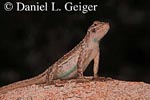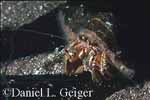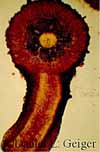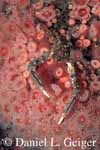|
Introduction
This file is intended to give you an introduction and on-line help concerning
the use of FileMaker data file SLIDES which has stored information on
zoological and marine biological slides available from Daniel Geiger.
The Slides HELP file contains
information on every field used in the data file; the FileMaker version
includes some general hints for the effective use of this powerful program:
especially "find".
All systematic names are
the scientific ones, and not a single common name is used. In the help-file,
terms printed in bold refer to a field in the data base and terms written
in CAPITAL LETTERS refer to a word used in the specific field.
Nobody is perfect ! Forgive
me all the deviations and mistakes in the file. Constant improvement
is guaranteed but this does not exclude long lasting errors.
This internet version 1.4.
is produced in April 1997. Please write to me in order to receive the
most recent version of the Slides file as well as the Slides HELP file,
either as FileMaker II, tab delimited or comma delimited files. Please,
indicate any difficulties you encountered using these data and help
files to me. You can contact me here.
Back to top of page and index.
Classification
 General:
This field gives information on the classification from the rank of
the phylum down to the Family, in some cases also to the subfamily (DECAPODA
MAIIDAE ... / SAURIA IGUANIDAE ...). The order of the taxa follows the
systematic ranking: first the phylum, then the class, order and last
the family. Intermediate levels are included where necessary or customary.
Genus and species name are indicated under Main Subject. Classification
gives no information on the species mentioned under Secondary Subjects.
A list of terms used in this field can be found here General:
This field gives information on the classification from the rank of
the phylum down to the Family, in some cases also to the subfamily (DECAPODA
MAIIDAE ... / SAURIA IGUANIDAE ...). The order of the taxa follows the
systematic ranking: first the phylum, then the class, order and last
the family. Intermediate levels are included where necessary or customary.
Genus and species name are indicated under Main Subject. Classification
gives no information on the species mentioned under Secondary Subjects.
A list of terms used in this field can be found here
The classification indicated
is the most up-to-date known to me and it depends a lot on which manual
was used for identification. Sometimes mismatches of different books
are indicated under Special. For recent monographs on which the classification
used here is based and for regional guides, see below.
Special indications: Some
special non-taxonomic terms are used in this field, and are listed and
explained below.
- BIOTOPE: This shows a
type of habitat or environment. Main Subject is always BIOTOPE. Under
Secondary Subjects the typical organisms are indicated sometimes along
with a rudimentary classification. The type of habitat is indicated
under Biotope.
- DIVER: A diver is the
main subject of the slide, which is also indicated under Main Subject.
- HERMIT CRAB: As the "hermit
crab" may have evolved several times-although this is somewhat disputed-,
I use this informal group name for this very typical crab form.
- INCERTAE SEDIS: Here
I know precisely which species I deal with (indicated under Main Subject)
but I do not know its full classification from the phylum down to
the Family. Such cases normally stem from photographs from zoos or
aquaria. The level of uncertainity is indicate as in UNIDENTIFIED.
- MANY: There are more
than 1 main subject, sometimes also the interaction of several organisms
is shown. Main Subject is 0 (zero) and all the species depicted are
indicated under Secondary Subjects sometimes along with a rudimentary
classification. Also TAXON MANY can occur, e.g. TELEOSTEI MANY means
that several fishes are depicted.
- UNIDENTIFIED: I failed
to make an identification even at least on the genus level. The actual
level of incertainty is indicated by the position where
- UNIDENTIFIED is indicated.
E.g. PORIFERA UNIDENTIFIED says that I don't know whether it is a
Demospongia, Sclerospongia, Calcarea ... but it is certainly not an
sea-squirt. ECHINODERMATA ECHINOIDEA REGULARIA UNIDENTIFIED means
that it is certainly not a heart-urchin but I ignore whether it is
a DIADEMATOIDA, CIDAROIDA, ECHINOIDA ...
- UNKNOWN: I do not have
a clue what organism that is. I only think it is biogenic and, therefore,
is included in this file. An approximate description is given under
Special.
List of recent taxonomic monographs
on which the higher systematics used in the slide file is based:
- Anthozoa (European):
Manuel, 1988: Synopsis of the British Fauna NS #18 rev. British Anthozoa.
- Cnidaria Hexacoralia
Anthozoa Madreporaria = Scleractinia: Wood: Corals of the World. TFH
publications
- Annelida Polychaeta:
Fauchald, 1971: The Polychaete Worms. Nat. Hist. Mus. L.A. County
- Mollusca Gastropoda Opisthobranchia:
Thompson, 1976 and Thompson & Brown, 1984: Biology of British Opisthobranch
Molluscs Vol. I & II. Ray Society, London.
- Mollusca Remainder: Mainly
Vaught, 1989: A Classification of the Living Mollusca. American Malacologists,
Inc. Melbourne, Florida.
- Arthropoda Pantopoda
= Pycnogonida: King, 1974: Synopsis of the British Fauna: Pycnogonida.
- Sipuncula and Echiurida:
Stephen & Edmonds, 1972: The phyla Sipuncula and Echiura. Trustees
BM(HN).
- Echinodermata Asteroidea:
Clark & Downey 1992: Starfishes of the Atlantic. Natural History Museum
Publications. Chapman & Hall, London.
- Chaetognatha: Bieri,
1991: Systematics of Chaetognatha. In: Bone et al. (eds.): The Biologgy
of Chaetognaths. Oxford University Press, Oxford.
- Chondichthyes, Teleostei,
Reptilia, Amphibia: Grzimek (ed.), 1980: Grzimeks Tierleben. dtv.
Major regional guides used:
- Mediterranean: Riedl,
1983: Fauna und Flora des Mittelmeeres. Paul Parey, Hamburg.
- North-West Atlantic:
Hayward & Ryland, 1991: Marine Fauna of the British Isles and Northwest
Europe Vol 1 & 2. Oxford University Press.
- Bermuda: Sterrer, 1986:
Marine Fauna of Bermuda. John Wiley, New York.
- North-West Pacific: Morris
et al. (eds.), 1983: Intertidal Invertebrates of California.
- Plankton: Todd & Laverack,
1991: Coastal Marine Zooplankton. Cambridge University Press, Cambridge
Trégouboff & Rose, 1957: Manuel de Planctonologie Méditeranéenne.
CNRS, Paris.
- Deserts: MacMahon 1992:
Deserts. Audubon Soc. Nat. Guide
Savage 1959: Lizards Snakes and Turtles of the West. Naturegraph Pocket
Keys Vol. 2
Back to top of page and index.
Other works used for identification:
- Arthropoda Arachnida:
Jackman, 1997: A Field Guide to Spiders and Scorpions of Texas. Texas
Monthly Fieldguide Series.
- Mammalia. Jameson & Peeters,
1988, California Mammals. University of California Press.
Main
Subject
 General: The main
aim of the picture is indicated with genus and species name using the
scientific, Linnean nomenclature. The higher taxa associated with the
species are indicated under Classification. "Main aim" of the shot means,
that the subject does not necessarily occupy the largest area of the
slide. If the area is really small, it is indicated under Special. General: The main
aim of the picture is indicated with genus and species name using the
scientific, Linnean nomenclature. The higher taxa associated with the
species are indicated under Classification. "Main aim" of the shot means,
that the subject does not necessarily occupy the largest area of the
slide. If the area is really small, it is indicated under Special.
ERRARE HUMANUM EST. The
Identification provided is to the best of my knowledge. Errors have,
do, and will occur. I try to improve the file at all the times, but
also I am just a human being. (I classified Arminia tigeriana
for two years under Plathemintes Turbellaria Unidentified and Lamellaria
sp. as Mollusca Gastropoda Opisthobranchia Pleurobranchomorpha Unidentified).
For the more important manuals used for identifcation, please see here.
Special indications:
- AFF. and CF.: As in general
scientific use: might be that species / has affinities to but is certainly
not the species.
- BIOTOPE: This shows a
type of habitat or environment. Classification is always BIOTOPE.
Under Secondary Subjects the typical organisms are indicated sometimes
along with a rudimentary classification. The type of habitat is indicated
under Biotope.
- DIVER: A diver is the
main subject. Classification then is DIVER, too.
- MANY: More than one equally
important subjects are depicted, which are indicated under Secondary
Subject. Classification is also MANY (cf. Classification).
- Scenic: The shows a scenery
from the particular location. For habitat information see under biotope.
- OR: Between two names,
giving alternative identifications, where the first is thought to
be a little bit more likely.
- 0 (zero): The identity
of the organism is not known even on the genus level. In Classification
either UNIDENTIFIED or UNKNOWN is indicated.
- =: Gives indications
on common synonyms encountered. With type specimens (see Classification)
the first taxon is the taxon of the type, the taxon after the = is
the senior synonym (if applicable).
Back to top of page and index.
Secondary
Subject

Eupagurus bernhardi in shell of Buccinum
undatum with epizoic Hydractinia echinata. |
General: The most important
side subjects and the species background - not the main aim of the shot
- are listed under Secondary Subject. For those subjects which I assume
to be commonly known (e.g. Symphydus: Teleostei Labridae), no classification
is indicated. Only for some weird taxa such a rudimentary classification
will help you to get an idea what it is about. An alternative possibility
is to check the respective taxon under Main Subject and check the classification
from that record.
Special indications:
DIVER: A diver is part of
the picture.
For those taxa which do not have a main subject (Main Subject MANY),
Secondary Subject identifies these equally important taxa and also the
taxa in the background. Use common sense to find out which is which.
Back to top of page and index.
Special

Fotomicrograph of tubefoot of sea urchin. |
General: Here I indicated all
further information:
- Technical photographic information: film, lens used, illumination, ±
correction, magnification etc.; see also below
- Orientation of animal: dorsal, ventral, oral, aboral, lateral etc.
- Biological information: eggs, spawn, male, female, parasites, symbiosis,
mutualism, behaviour etc.
- Identification: identified (det.) by ..., after book xy, etc.
- Odds and Sods: by night, not reported from that locality, atypical colouration
etc.
- COMPARE TO # XYZ: Compare the present slide or record to the one recorded
under the Number XYZ.
- Variation: As one set mostly is composed of more than one slide (up
to 97) and no slide is exactly the same, I indicate the variation under
special.
- Origin of specimen: when the specimen is not photographed in its natural
habitat in the wild, its habitat or the sampling method (VAN VEEN GRAB,
TRAWL, DIVE) is usually indicated.
Equipement used:
Pre 1987 photographs were taken with a Yashica FX-D and a Tokina 35-105mm
f4.5
After 1987 all surface photographs are taken with Olympus equipement,
based on OM4 and OM3. Underwater photographs form 1987 to 1991 have been
taken with a OM4, Winder 2, 50mm Macro f3.5 in a Hugyflex aluminum underwater
housing, with a Subatec HST 2000 OM-TTL-flash. From 1992 on all under
water pictures have been taken with a Pentax LX, 45° viewfinder, winder,
100 mm AF Macro or a 24 mm MF lens in a Hugyfot Ufomarin-Accu Aluminum
housing and an Aquatron SII Pentax-TTL-flash.
Films used:
Up to 1993 most slides are done with a Kodak Chrome 64 (24x36mm) film
stated as KC 64 under special. From 1995 on Fuji Provia and Velvia have
been used. Other films include KC 200, Ektachrome P800/1600, Agfachrome
1000RS and some other odd Agfachrome. Black and white pictures (negatives)
are not catalogued, despite the fact that I have a couple of them, i.e.
some birds and some mammals. Please contact
me for details.
Back to top of page and index.
Biotope
 General: Here the
type of biotope is indicated. Unfortunately there is no standardised
nomenclature for a biotope. I tried to use widely known terms as CORAL
REEF, MANGROVE, SAND, ALGAE, ROCK, LITORAL, TIDE POOL which are qualified
by further terms, e.g. LITORAL FUCUS SERRATUS BELT. General: Here the
type of biotope is indicated. Unfortunately there is no standardised
nomenclature for a biotope. I tried to use widely known terms as CORAL
REEF, MANGROVE, SAND, ALGAE, ROCK, LITORAL, TIDE POOL which are qualified
by further terms, e.g. LITORAL FUCUS SERRATUS BELT.
Special indications:
- AQUARIUM: Pictures taken
in aquaria are indicated ARTIFICIAL AQUARIUM.
- ARTIFICIAL: All pictures
which were not taken in the wild are indicated by ARTIFICIAL. This
does not necessarily mean, that one also realises it, especially in
the macro-photographs! ARTIFICIAL is often qualified by other terms.
- MAS: Meters above sea-level.
- DIVE NO. XYZ: Dive number
refers to my log-book.
- ZOO: Pictures taken in
a zoo are indicated by ARTIFICIAL ZOO.
Back to top of page and index.
Locality
 General: The
location starts with the country and state and then some subordinate geographical
indications. Mostly the date of the shot is indicated approximately. General: The
location starts with the country and state and then some subordinate geographical
indications. Mostly the date of the shot is indicated approximately.
Special indications: Some deviations have been used:
- BALEARES, ...: W-Mediterranean,
Spain, Balearic Islands
- BANDOL: ILE DE BENDOR:
Southern France between Marseille and Toulon
- BANYULS SUR MER: S-France
just at the border to Spain
- BMK: Beim Buremichelskopf:
refers to my Basel, Switzerland address.
- BM(NH): British Museum
(Natural History), London, UK
- QUIRIAT SCHMONA: Very
North of Israel (Å 10km S of the border to Lebanon) very close to
Jordan River
- W(DC): Washington (DC)
- A.w. B.CD: A-th week
of the b-th month of the CD-year.
Back to top of page and index.
Quality
General: The subjective quality of the slide is indicated using a five
step classification. The following guide-lines have been followed:
Major steps:
BAD: There are serious mistakes in the picture (out of focus, under/over-exposed,
reflections, blurred ...). I still keep these slides for something like
sentimental reasons, or as it is the only picture of that particular
subject I have.
FINE: Average quality, technically and photographically: In focus, balanced
illumination, reasonable composition. The majority of the slides has
this attribute.
GEM: A very nice shot, which can easily keep up with photographs in
the National Geography Magazine (My personal opinion and taste). Technically
perfect: Focal plane on the closest part of the animal or on the eye
and enough depth of field, perfect illumination with no pitch black
and over-white areas, no flat illumination, still some modelling shadows
but no strong shadows. Very nice composition: The picture as it was
taken stands on its own and every alteration of the format would not
be to the benefit of the picture: that's my taste, of course.
Intermediate steps (BAD FINE, FINE GEM) are occasionally used so that
there are five quality steps.
Back to top of page and index.
Samplesize
& Total
Samplesize
General: Of most subjects I have taken more than one slide (up to 97).
The actual number is indicated in Samplesize. As no picture is exactly
the same as the other, the variation (technically or of the subject)
are indicated in Special. If you select several data sheets, Samplesize
indicates the number of slides in the uppermost (screen) data sheet.
Total
General: Total indicates the total number of slides selected (· Samplesize
i: i is indicated under the book below Found).
Special indication: Total is always calculated if the Total is indicated
in the current layout. This may take some time if you select a bigger
part of the data file. You can cancel this summation by the ð-. (period)
operation. Alternatively you may create a new layout without Total.
For details of making a new layout see under Custom & Layout in the
HELP-file.
Back to top of page and index.
Depth
from ... to ...
General: This field only applies for under water pictures taken in the
field and the depth is indicated in meters. The depth range given is
for the whole serie of slides; intermediate depths may occur in sample-sizes
>2. For samplesize =2 the two depths are the ones of the two slides.
For sample-size =1 the two depths are equal. All depths are indicated
in meters. The field is a numerical field (as opposed to text). This
allows find procedures using logic operators (>, <, = ).
All non-underwater-field-pictures have the value 0 (zero). This includes
outdoor land pictures (e.g. insects). You may distinguish outdoor land
pictures from non-field underwater and through water pictures by means
of the word ARTIFICIAL in the field Biotope, which does not appear in
the outdoor land pictures.
Special indications:
?: I do not know the depth at which the picture was taken.
Back to top of page and index.
Number
& Copyright
Number
General: For each slide series a serial number is allocated. This facilitates
finding the correct data for a slide you hold in your hands, which is
especially important when several slides with the same subject are checked,
e.g. there are 21 Classification PORIFERA UNIDENTIFIED with a total
of 29 slides !
If you refer to a certain set of slides always use this number as a
reference.
Copyright
General: Here I mark who has which copies of my slides. I also obtained
some slides from other people on which they have the copyright.
Back to top of page and index.
Thumbnails
 I have scanned
in thumbnails of my slides, currently approximately 3,700 out of over
7,000 series and 23'000 pictures. A selection is availble in the gallery. I have scanned
in thumbnails of my slides, currently approximately 3,700 out of over
7,000 series and 23'000 pictures. A selection is availble in the gallery.
|
 General: The
location starts with the country and state and then some subordinate geographical
indications. Mostly the date of the shot is indicated approximately.
General: The
location starts with the country and state and then some subordinate geographical
indications. Mostly the date of the shot is indicated approximately. I have scanned
in thumbnails of my slides, currently approximately 3,700 out of over
7,000 series and 23'000 pictures. A selection is availble in the gallery.
I have scanned
in thumbnails of my slides, currently approximately 3,700 out of over
7,000 series and 23'000 pictures. A selection is availble in the gallery.
 General:
This field gives information on the classification from the rank of
the phylum down to the Family, in some cases also to the subfamily (DECAPODA
MAIIDAE ... / SAURIA IGUANIDAE ...). The order of the taxa follows the
systematic ranking: first the phylum, then the class, order and last
the family. Intermediate levels are included where necessary or customary.
Genus and species name are indicated under Main Subject. Classification
gives no information on the species mentioned under Secondary Subjects.
A list of terms used in this field can be found
General:
This field gives information on the classification from the rank of
the phylum down to the Family, in some cases also to the subfamily (DECAPODA
MAIIDAE ... / SAURIA IGUANIDAE ...). The order of the taxa follows the
systematic ranking: first the phylum, then the class, order and last
the family. Intermediate levels are included where necessary or customary.
Genus and species name are indicated under Main Subject. Classification
gives no information on the species mentioned under Secondary Subjects.
A list of terms used in this field can be found  General: The main
aim of the picture is indicated with genus and species name using the
scientific, Linnean nomenclature. The higher taxa associated with the
species are indicated under Classification. "Main aim" of the shot means,
that the subject does not necessarily occupy the largest area of the
slide. If the area is really small, it is indicated under
General: The main
aim of the picture is indicated with genus and species name using the
scientific, Linnean nomenclature. The higher taxa associated with the
species are indicated under Classification. "Main aim" of the shot means,
that the subject does not necessarily occupy the largest area of the
slide. If the area is really small, it is indicated under 

 General: Here the
type of biotope is indicated. Unfortunately there is no standardised
nomenclature for a biotope. I tried to use widely known terms as CORAL
REEF, MANGROVE, SAND, ALGAE, ROCK, LITORAL, TIDE POOL which are qualified
by further terms, e.g. LITORAL FUCUS SERRATUS BELT.
General: Here the
type of biotope is indicated. Unfortunately there is no standardised
nomenclature for a biotope. I tried to use widely known terms as CORAL
REEF, MANGROVE, SAND, ALGAE, ROCK, LITORAL, TIDE POOL which are qualified
by further terms, e.g. LITORAL FUCUS SERRATUS BELT.